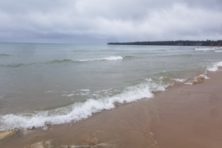Wild Things: COVID-19 Doesn’t Stop Shoppers but Guts Second Spring Hearing
- Share
- Tweet
- Pin
- Share
For the second straight year, the Wisconsin Conservation Congress and Department of Natural Resources (DNR) have announced that the annual spring hearings will be online only because of the COVID-19 pandemic.
With case numbers falling rapidly and big-box stores packed with hundreds of shoppers every hour, it’s hard for this writer to understand why a meeting that rarely draws more than a few dozen people to auditoriums in every county needs to be canceled.
Social distancing? No problem. Masks? Double up if you’re concerned. There’s a stay-at-home option, too.
But for the rest of us, the spring DNR hearings and county Conservation Congress meetings are the one time each year when passionate outdoors folks can get together to debate proposals and advisory questions concerning fisheries, wildlife and all things natural resources.
Though the votes are nonbinding and advisory only, the annual gatherings – in place since the 1930s – still provide the DNR and politicians with a good sense of the pulse of key stakeholders.
The State Conservation Commission (the predecessor of the Natural Resources Board) created the Conservation Congress in 1934, giving citizens a way to exchange input on local and state conservation issues.
In 1972, Gov. Patrick Lucey signed legislation that legally recognized the Conservation Congress to ensure that citizens would have a liaison between the state Natural Resources Board and the DNR.
For the second straight year, there will be no voting for local representation to the Congress. Instead, terms will again be extended, but if the current delegate no longer wishes to serve, the seat will become vacant and the county chair can appoint someone.
Members of the public will have the opportunity to submit citizen resolutions online between now and April 5, and beginning April 12, they can vote. In addition to any local resolutions, there are 23 proposed changes related to fisheries and five related to wildlife management, as well as advisory questions from the DNR, Natural Resources Board and Conservation Congress.
Online input will begin April 12, 7 pm, and remain open for 72 hours.
There are not many local questions this year. One asks whether you support a daily bag limit of five and continuous open season for lake trout on Lake Michigan. Another wants to know whether you’d like to see gray and fox squirrel seasons end the same day as cottontail rabbit hunting – the last day of February.
Advisory questions seeking to gauge public input are more interesting. There’s one asking whether you’d support a $5 increase in the Great Lakes Salmon and Trout Stamp, which has been $10 since 2004; another asking whether all ATV/UTV and hunter-education classes should be in-person only; and – likely to draw the most headlines statewide – one asking whether you support the harvest of white (not albino) deer.
Take a closer look at all the questions, and find out how to craft and submit your own resolution at dnr.wisconsin.gov/about/wcc/springhearing.
Spring County Deer Advisory Council Meetings
County Deer Advisory Councils will meet during the coming weeks to develop recommendations for antlerless harvest goals, antlerless tag availability and season options for their county. They’ll be virtual only, with options to join by Zoom or phone.
Kewaunee County’s meeting will be March 24, 6 pm. You can listen in at 312.626.6799 using code 840 4108 6235. Door County’s meeting is set for March 29, 6 pm. The phone number is the same, but the code is 837 8527 0425.
A public-comment period will follow, April 12-25, and each council will hold final objective-setting meetings in early May. The state Natural Resources Board is expected to approve the recommendations June 23.
Learn more at dnr.wisconsin.gov/topic/Hunt/cdac.
Cleaner Fox, Cleaner Fish
A 17-year cleanup of the Lower Fox River was completed late last year. The project removed 6.5 million cubic yards of contaminated sediment and installed caps on more than 275 acres of riverbed to contain PCBs. Sand was also installed to cover 780 acres.
Current results show PCB reductions of approximately 90% in river water and sediment compared to concentrations in 2006.
The DNR and Department of Health Services offer a “Choose Wisely” booklet outlining safe-eating guidelines for fish based on contaminant levels. There’s less restrictive advice for certain species since the last printing in 2016. Find out more at dnr.wisconsin.gov/topic/Fishing/consumption.
Fishing Heating Up
Some giant fish have been hooked of late, including some real trophy pike, trout, walleye and perch on the season’s last ice. Check Howie’s Tackle’s Facebook page for photos, and stop by your favorite bait shop for the latest reports on ice and open-water possibilities.
Wild Turkey Leftovers
Forgot to apply for a spring wild turkey hunting permit, or want to try for an extra? Check out the list at dnr.wisconsin.gov/permits/springturkey.html. Permits will go on sale next week. There are more than 14,700 left in Zone 2 for the last two time periods.
Water-Levels Update
As of March 5, Lake Michigan was 38 inches above its 100-year monthly average but nine inches below last year’s monthly record. Water levels were still up 55 inches from the record monthly low, set in 1964.



